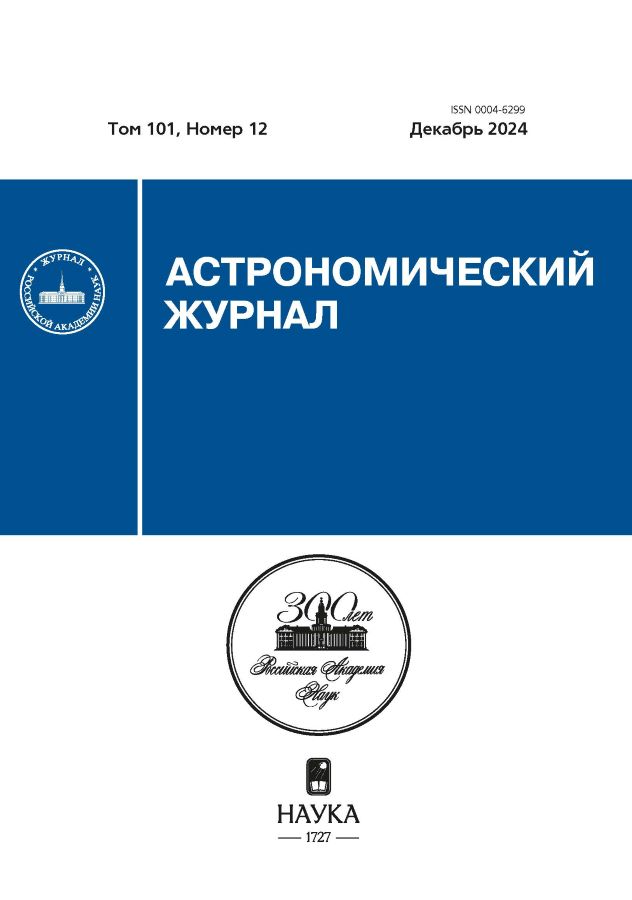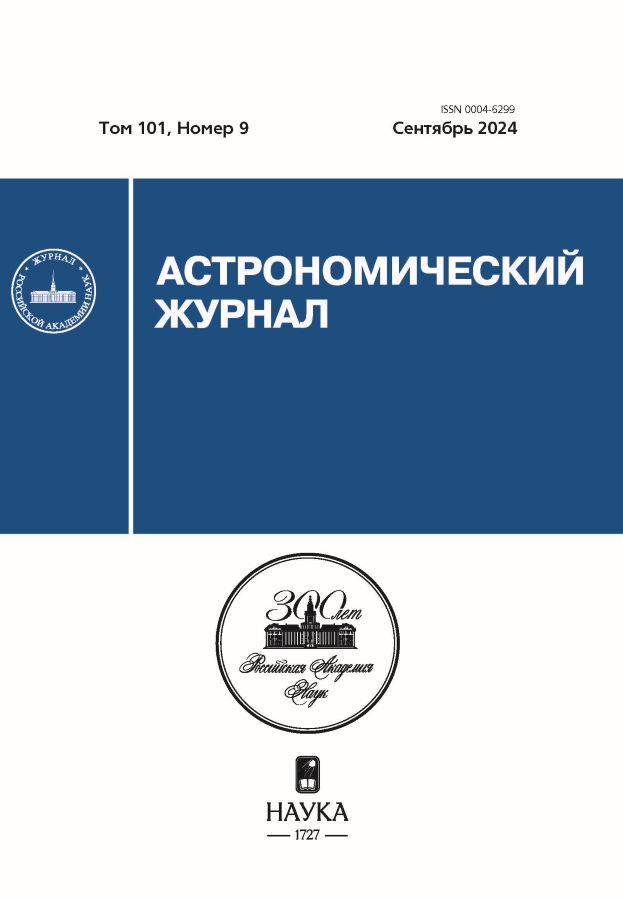Study of maser emission in 18 cm lines in the star formation region G 109.871+2.114 (Cep A)
- Authors: Lekht E.E.1, Ashimbaeva N.T.1, Krasnov V.V.2, Shoutenkov V.R.2
-
Affiliations:
- Lomonosov Moscow State University
- P. N. Lebedev Physical Institute, Russian Academy of Sciences
- Issue: Vol 101, No 9 (2024)
- Pages: 839-850
- Section: Articles
- URL: https://j-morphology.com/0004-6299/article/view/647661
- DOI: https://doi.org/10.31857/S0004629924090046
- EDN: https://elibrary.ru/IBEKDQ
- ID: 647661
Cite item
Abstract
The results of the study of the star formation region G 109.871+2.114 (Cep A) in OH lines by 18 cm are presented. Polarization observations (monitoring) were performed on a large radio telescope in Nançay (France) in 2007–2024. OH maser emission is highly variable. The structure of the spectrum and the flux density of the individual features are changing. However, the radial velocities of most features changed slightly. Short-term flares of emission ion from individual features were observed. Many features have strong circular polarization, reaching 100%, but weak linear polarization. A new features at –15.53 km/s and a short-term part at 1.58 km/s with high circular and low linear polarizations were detected in the 1667 MHz line. The spectral features of our monitoring were spatially identified with the maser spots on the Cohen, Argon and Fish maps. The magnitude of the monotonic decrease in splitting, and, consequently, the longitudinal magnetic field of three Zeeman pairs (–16.2L / –14.25R km/s and –6.94L / –0.82R in the 1665 MHz line and –15.76L / –14.2R in the 1667 MHz line). For the –13.95L / –11.60R pair no splitting change was detected in the 1665 MHz line. Broadband absorption and emission are observed in the satellite lines of 1612 and 1720 MHz, respectively. A Zeeman pair was also detected in the 1720 MHz line. The value of the positional angle χ is calculated for linearly polarized emission of most spectral details in both main lines of 1665 and 1667 MHz. It is shown that the magnetic field in the H II regions is oriented either along the external magnetic field or along the radio jets.
Full Text
About the authors
E. E. Lekht
Lomonosov Moscow State University
Author for correspondence.
Email: eelekht@mail.ru
Sternberg Astronomical Institute
Russian Federation, MoscowN. T. Ashimbaeva
Lomonosov Moscow State University
Email: eelekht@mail.ru
Sternberg Astronomical Institute
Russian Federation, MoscowV. V. Krasnov
P. N. Lebedev Physical Institute, Russian Academy of Sciences
Email: eelekht@mail.ru
Astrospace Center
Russian Federation, MoscowV. R. Shoutenkov
P. N. Lebedev Physical Institute, Russian Academy of Sciences
Email: eelekht@mail.ru
Pushchino Radio Astronomy Observatory, Astrospace Center
Russian Federation, PushchinoReferences
- V. A. Hughes, and J. G. A. Wouterloot, 276, 204 (1984).
- V. A. Hughes, 333, 788 (1988).
- S. Curiel, M. A. Trinidad, J. Canto, L. F. Rodriguez, et al., 564(1), L35 (2002).
- S. Dzib, L. Loinard, L. F. Rodrguez, A. J. Mioduszewski, and R. M. Torres, 733(1), id. 71 (2011).
- L. Moscadelli, M. J. Reid, K. M. Menten, A. Brunthaler, X. W. Zheng, and Y. Xu, 693(1), 406 (2009).
- V. A. Hughes, R. J. Cohen, and S. Garrington, Monthly Not. Roy. Astron. Soc. 272(2), 469 (1995).
- L. F. Rodrguez, G. Garay, S. Curiel, S. Ramrez, J. M. Torrelles, Y. Gómez, and A. Velázquez, Astrophys. J. Letters 430, L65 (1994].
- V. A. Hughes, 563(2), 919 (2001).
- L. F. Rodrguez, J. M. Torrelles, G. Anglada, and J. Mart, Revista Mexicana Astron. Astrof. 37, 95 (2001).
- J. M. Torrelles, J. F. Gómez, L. F. Rodríguez, S. Curiel, P. T. P. Ho, and G. Garay, Astrophys. J. Letters 457, L107 (1996).
- J. M. Torrelles, N. A. Patel, J. F. Gómez, and P. T. P. Ho, et al., 560(2), 853 (2001).
- J. M. Torrelles, J. F. Gómez, G. Garay, L. F. Rodrguez, S. Curiel, R. J. Cohen, and P. T. P. Ho, 509(1), 262 1998.
- М. И. Пащенко, Г. М. Рудницкий, О. Франкелен, Письма в Астрон. журн. 5, 276 (1979).
- V. L. Fish and M. J. Reid, Astrophys. J. Suppl. 164(1), 99 (2006).
- R. J. Cohen, P. R. Rowland, and M. M. Blair, Monthly Not. Roy. Astron. Soc. 210, 425 (1984).
- A. Bartkiewicz, M. Szymczak, R. J. Cohen, and A. M. S. Richards, Monthly Not. Roy. Astron. Soc. 361(2), 623 (2005).
- В. И. Слыш, М. И. Пащенко, Г. М. Рудницкий, В. М. Витрищак, П. Колом, Астрон. журн. 87(7), 655 (2010).
- Н. Т. Ашимбаева, Е. Е. Лехт, М. И. Пащенко, В. В. Краснов, А. М. Толмачев, Астрон. журн. 99, 628 (2022).
- V. L. Fish, M. J. Reid, A. L. Argon, and X.-W. Zheng, Astrophys. J. Suppl. 160(1), 220 (2005).
- A. L. Argon, M. J. Reid and K. M. Menten, Astrophys. J. Suppl. 129(1), 159 (2000).
- R. F. Haynes and J. L. Caswell, Monthly Not. Roy. Astron. Soc. 178, 219 (1977).
- Н. Т. Ашимбаева, Е. Е. Лехт, В. В. Краснов, А. М. Толмачев, Астрон. журн. 100, 593 (2023).
Supplementary files

























